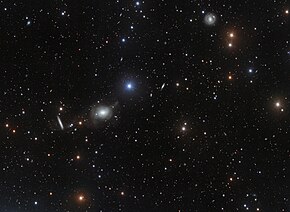NGC 5018
Appearance
From Wikipedia, the free encyclopedia
Elliptical galaxy in the constellation Virgo
| NGC5018 | |
|---|---|
 NGC 5018 taken by ESO'sVery Large Telescope.[1] | |
| Observation data (J2000[2]epoch) | |
| Constellation | Virgo |
| Right ascension | 13h13m01.000s[2] |
| Declination | −19° 31′ 05.87″[2] |
| Redshift | 0.009413[2] |
| Heliocentric radial velocity | 2809km/s[2] |
| Distance | 132.51 Mly |
| Apparent magnitude(B) | 11.71[2] |
| Characteristics | |
| Type | S...[2] |
| Other designations | |
| 6dFGS gJ131301.0-193106,ESO576-10,ESO-LV 576-0100, GSC 06116-01096, IRAS 13103-1915, IRAS F13103-1915, ISOSS J13130-1931, LEDA 45908,2MASXJ13130099-1931058,MCG-03-34-017, PSCz Q13103-1915, SGC 131020-1915.3,UGCA 335, [CHM2007] HDC 772 J131300.99-1931058, [CHM2007] LDC 955 J131300.99-1931058, [FWB89] Galaxy 337, [M98c] 131020.0-191518, [SLK2004] 800[2] | |
NGC 5018is anelliptical galaxylocated in the constellation of Virgo at an approximate distance of 132.51 Mly.NGC 5018 was discovered in 1788 byWilliam Herschel.
Threesupernovaehave been observed in NGC 5018: SN 2002dj, (type Ia,mag. 17),[3]SN 2017isq (type Ia, mag. 15.3),[4]and SN 2021fxy (type Ia, mag. 13.9).[5]
See also[edit]
References[edit]
- ^"Elliptical elegance".eso.org.Retrieved2018-08-09.
- ^abcdefgh"SIMBAD Astronomical Database - CDS (Strasbourg)".Results for NGC 5018.Retrieved2018-08-09.
- ^Transient Name Server entry for SN 2002dj.Retrieved 23 March 2023.
- ^Transient Name Server entry for SN 2017isq.Retrieved 23 March 2023.
- ^Transient Name Server entry for SN 2021fxy.Retrieved 23 March 2023.
External links[edit]
 Media related toNGC 5018at Wikimedia Commons
Media related toNGC 5018at Wikimedia Commons
Thiselliptical galaxyarticle is astub.You can help Wikipedia byexpanding it. |
Retrieved from "https://en.wikipedia.org/w/index.php?title=NGC_5018&oldid=1146316813"
